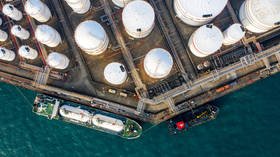Asia to account for 90% of global oil demand growth through 2025 – IEA

Despite speculation that oil demand peaked in 2019, before the global pandemic hit the industry hard, a new IEA report suggests this assumption may have been overstated as demand is set to continue increasing until 2026.
Innovations in renewable energy and the decreased demand in response to the Covid-19 pandemic made experts believe the oil era was slowly losing momentum. However, as the Asian market grows and many countries return to pre-pandemic demand levels, this may not be true.
According to the new IEA report, demand for oil could hit pre-pandemic levels within the next two years. By 2023, oil production could exceed 100m bpd if world demand, driven significantly by Asia, continues at its current growth rate.
Also on rt.com 'We said: Inshallah': US sanctions fail to prevent Iran from selling record amount of crude to energy-hungry ChinaWhile oil demand may not return to pre-pandemic levels in most developed countries, due to travel and work changes that have driven demand down over the last year and look set to stay as well as greater uptake of electric vehicles and other renewable options, demand across the developing world as well as major consumers like China could be the main drivers of this demand.
Watch more on Oilprice.com: Why the oil & gas rig count Mmatters
Asia is expected to account for around 90% of the world’s growing oil demand over the next five years. Although demand may not increase at the same rate at pre-2019, growing populations will add significantly to the oil-needs of several Asian countries such as India and China.
Advances in renewable energy, particularly the development of solar power infrastructure in the developing South where sun is an abundant resource, as well as the pressure from governments and companies to meet net-zero carbon emission objectives, could drive oil and gas demand down over the next decade. But not before it peaks prior to the fall.
Also on rt.com Russia looks to replace banned Australian coal exports to ChinaThe uptake of electric vehicles, driven primarily by Europe, China and the USA, is also expected to push down oil demand by 2030. Deloitte predicts a 29% CAGR for the EV market over the next decade, with sales of EV increasing from 2.5 million in 2019 to 31.1 million in 2030. However, the impact of Covid-19 on many world economies has stalled EV progress, which is expected to pick up again from 2022/23, just as oil demand reaches its new peak.
As demand steadily rises, OPEC’s energy supply curbs over the last few months could present a significant advantage for the oil-rich region. The IEA has outlined the "hefty amount of spare production capacity" brought about by OPEC restrictions to drive up oil prices this year. However, it also anticipates a growth of 700,000 bpd of oil supply for non-OPEC states in 2021.
Also on rt.com China ramps up oil imports from IranThe OPEC strategy of restricting oil production until oil prices stabilised appears positive for the industry as a whole, which is now looking towards a 2021 of increased oil demand at higher prices.
Overall, as economies across the globe stabilise and the vaccine shows promise to experts that were unsure about the potential for oil following the 2020 demand dive, the oil industry will continue to meet a growing global demand until renewable technologies and greener policies eventually force countries to look towards alternatives.
This article was originally published on Oilprice.com














